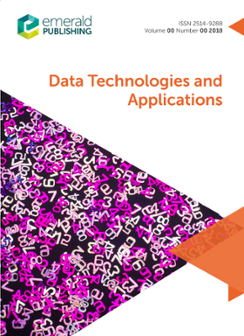Data Technologies and Applications
Issue(s) available: 31 – From Volume: 52 Issue: 1, to Volume: 58 Issue: 3

Volume 54
MD-LDA: a supervised LDA topic model for identifying mechanism of disease in TCM
Meiwen Li, Liye Xia, Qingtao Wu, Lin Wang, Junlong Zhu, Mingchuan ZhangIn traditional Chinese medicine (TCM), the mechanism of disease (MD) constitutes an essential element of syndrome differentiation and treatment, elucidating the mechanisms…
Early identification of high attention content for online mental health community users based on multi-level fusion model
Song Wang, Ying Luo, Xinmin LiuThe overload of user-generated content in online mental health community makes the focus and resonance tendencies of the participating groups less clear. Thus, the purpose of this…
Tracking the size of the estimation window in time-series data
Tae Yeon KwonThis paper introduces a novel method, Variance Rule-based Window Size Tracking (VR-WT), for deriving a sequence of estimation window sizes. This approach not only identifies…
Practice challenge recommendations in online judge using implicit rating extraction and utility sequence patterns
Ramesh P Natarajan, Kannimuthu S, Bhanu DThe existing traditional recommendations based on content-based filtering (CBF), collaborative filtering (CF) and hybrid approaches are inadequate for recommending practice…
A novel similarity measure SF-IPF for CBKNN with implicit feedback data
Rajalakshmi Sivanaiah, Mirnalinee T T, Sakaya Milton RThe increasing popularity of music streaming services also increases the need to customize the services for each user to attract and retain customers. Most of the music streaming…
A novel neural network architecture and cross-model transfer learning for multi-task autonomous driving
Youwei Li, Jian QuThe purpose of this research is to achieve multi-task autonomous driving by adjusting the network architecture of the model. Meanwhile, after achieving multi-task autonomous…
Application of deep learning model incorporating domain knowledge in international migration forecasting
Tongzheng Pu, Chongxing Huang, Haimo Zhang, Jingjing Yang, Ming HuangForecasting population movement trends is crucial for implementing effective policies to regulate labor force growth and understand demographic changes. Combining migration theory…
Efficient software mutation test by clustering the single-line redundant mutants
Bahman Arasteh, Ali GhaffariReducing the number of generated mutants by clustering redundant mutants, reducing the execution time by decreasing the number of generated mutants and reducing the cost of…
Exploring cross-cultural disparities in tourists' perceived images: a text mining and sentiment analysis study using LDA and BERT-BILSTM models
Qiuying Chen, Ronghui Liu, Qingquan Jiang, Shangyue XuTourists with different cultural backgrounds think and behave differently. Accurately capturing and correctly understanding cultural differences will help tourist destinations in…
A Bayesian Inference-based approach for extracting driving data with implicit intention
Ping Huang, Haitao Ding, Hong Chen, Jianwei Zhang, Zhenjia SunThe growing availability of naturalistic driving datasets (NDDs) presents a valuable opportunity to develop various models for autonomous driving. However, while current NDDs…
False alarm detection in intensive care unit for monitoring arrhythmia condition using bio-signals
Aleena Swetapadma, Tishya Manna, Maryam SamamiA novel method has been proposed to reduce the false alarm rate of arrhythmia patients regarding life-threatening conditions in the intensive care unit. In this purpose, the…
ID-SF-Fusion: a cooperative model of intent detection and slot filling for natural language understanding
Meng Zhu, Xiaolong XuIntent detection (ID) and slot filling (SF) are two important tasks in natural language understanding. ID is to identify the main intent of a paragraph of text. The goal of SF is…
Light field image coding using a residual channel attention network–based view synthesis
Faguo Liu, Qian Zhang, Tao Yan, Bin Wang, Ying Gao, Jiaqi Hou, Feiniu YuanLight field images (LFIs) have gained popularity as a technology to increase the field of view (FoV) of plenoptic cameras since they can capture information about light rays with…
Sleep arousal detection for monitoring of sleep disorders using one-dimensional convolutional neural network-based U-Net and bio-signals
Priya Mishra, Aleena SwetapadmaSleep arousal detection is an important factor to monitor the sleep disorder.
Community relations discovery methods for users in Fancircle based on sentiment analysis in China
Kai WangThe identification of network user relationship in Fancircle contributes to quantifying the violence index of user text, mining the internal correlation of network behaviors among…
ISSN:
2514-9288Renamed from:
Program: electronic library and information systemsOnline date, start – end:
2018Copyright Holder:
Emerald Publishing LimitedOpen Access:
hybridEditor:
- Prof Miguel-Ángel Sicilia-Urban
